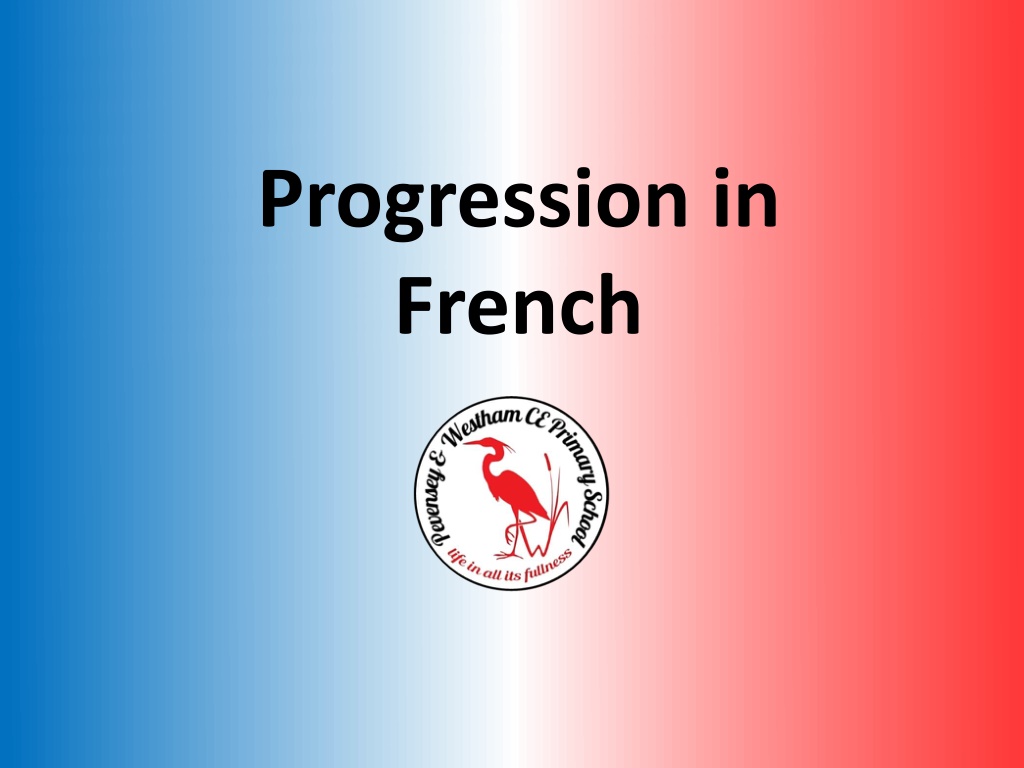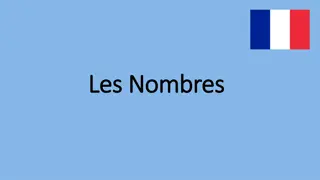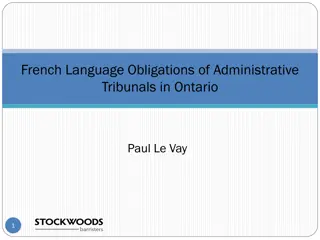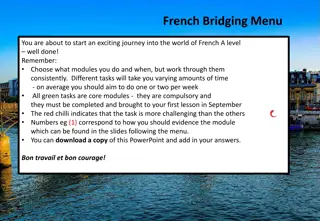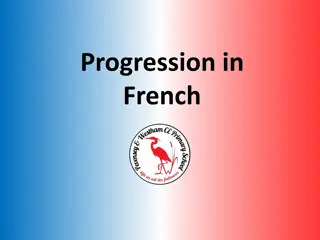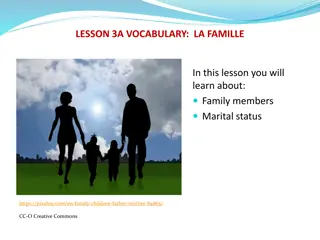Year 3 French Progression and Learning Objectives
Year 3 French curriculum focuses on developing speaking, writing, and comprehension skills, introducing key language structures, vocabulary, and grammar concepts. Students learn to describe living spaces, engage in basic conversations, recognize fruits, and engage with interactive activities to enhance language retention. The program emphasizes multisensory learning approaches, phonics, pronunciation, and encourages self-assessment for all learners to achieve proficiency in French language basics.
Download Presentation

Please find below an Image/Link to download the presentation.
The content on the website is provided AS IS for your information and personal use only. It may not be sold, licensed, or shared on other websites without obtaining consent from the author.If you encounter any issues during the download, it is possible that the publisher has removed the file from their server.
You are allowed to download the files provided on this website for personal or commercial use, subject to the condition that they are used lawfully. All files are the property of their respective owners.
The content on the website is provided AS IS for your information and personal use only. It may not be sold, licensed, or shared on other websites without obtaining consent from the author.
E N D
Presentation Transcript
Progression in French
Year 3 I am learning French/Japprends le fran ais Frenc h Skill to develop To speak and write using longer more interesting sentences, that include key structures presented in the unit. Describe whether they live in a house or apartment and what rooms there are. Learn to remember previous language and use alongside new knowledge. Substantive Knowledge Pinpoint France on a map and recall one or more other French speaking country in the world. Ask and answer the question How are you? in French. Say Hello and Goodbye in French. Ask and answer the question What is your name? in French. Count to 10 in French. Say 10 colours in French. Year 3 French End Points Pupils making a good level of progress will be able to: Listen to and enjoy short stories, nursery rhymes & songs. Recognise familiar words and short phrases covered in the units taught. Communicate with others using simple words and short phrases covered in the units. Read familiar words and short phrases accurately by applying knowledge from 'Phonics & Pronunciation Lesson 1'. Understand the meaning in English of short words read in French. Write familiar words & short phrases using a model or vocabulary list. E.g., ' 'I like apples . Start to understand the concept of noun gender and the use of articles. Use the first person singular version of high frequency verbs. E.g., 'I like 'I am called ' Spotlight on SEND Multisensory approach, using a wide range of audio, visual and kinaesthetic teaching styles throughout all levels of learning, to support working memory. Colourful, engaging and interactive lessons, fun karaoke songs, and appropriate desk-based activities suitable for pupils of all abilities. Repetition and practice with focus on the visualisation of the information presented along with rhythmic regulatory exercises used as much as possible. Range of differentiated desk-based tasks that cover all 4 key language learning skills speaking, listening, reading and writing. SEND friendly version of activities where appropriate to help ensure every child can achieve ambitious yet realistic outcomes. Extra interactive games, karaoke videos and Language Angels app available to further consolidate learning outside the classroom. End of unit self-assessment is suitable for all pupils as it is adapted to contain visual prompts to ensure we celebrate what all pupils Phonics and pronunciation Phonics focus: CH OU ON OI OI sound in trois & noir ON sound in marron OU sound in rouge Silent letters. The s in gris, t in vert and violet, c in blanc, x in deux and the s in trois. There are many silent letters at the end of French words. Guttural R . Becoming more familiar with the French r sound as seen in noir, orange, gris, marron, vert, rouge, trois & quatre. Made from the back of the mouth, not the front. Elision. Je m appelle. Dropping of the last letter of a word (in this case the e in me) and replacing it with an apostrophe. Attaching it to the word that follows which begins with a vowel or mute h . This is in order to facilitate pronunciation. It is not optional in French. Language Angels J apprends le fran ais
Year 3 Fruits / les fruits Frenc h Skill to develop Work on memory, recall and retention skills using images as prompts. Learn how to ask a question and answer it in French, including a simple opinion. Substantive Knowledge Name and recognise up to 10 fruits in French. Attempt to spell some of these nouns. Ask somebody in French if they like a particular fruit. Say what fruits they like and dislike. Year 3 French End Points Pupils making a good level of progress will be able to: Listen to and enjoy short stories, nursery rhymes & songs. Recognise familiar words and short phrases covered in the units taught. Communicate with others using simple words and short phrases covered in the units. Read familiar words and short phrases accurately by applying knowledge from 'Phonics & Pronunciation Lesson 1'. Understand the meaning in English of short words read in French. Write familiar words & short phrases using a model or vocabulary list. E.g., ' 'I like apples . Start to understand the concept of noun gender and the use of articles. Use the first person singular version of high frequency verbs. E.g., 'I like 'I am called ' Phonics and pronunciation Phonics focus: CH OU ON OI OI sound in poire Silent letters. We will see that the letter s is not pronounced in les or the plural version of the fruits as final consonants are nearly always silent letters in French. Liaison. Understanding better that liaison is the word to explain what happens with pronunciation when a word that ends in a normally silent consonant is followed by a word starting with a vowel. The normally silent s in les is pronounced in les oranges and les abricots as both those fruits start with a vowel but the s almost sounds like a z . This happens often in French. Guttural R . Becoming more familiar with the French r sound as seen infraise, orange, poire, prune, cerise & abricot. Made from the back of themouth, not the front. Spotlight on SEND In line with our school policy, we ensure inclusion using our Learning Principles to review and scaffold learning as well as constructing enquiries which are graduated in bite size steps allowing for the setting of personalised targets, a broad range of learning and teaching strategies including questioning, working with additional adults where appropriate and a holistic approach to assessing achievement. Language Angels Les fruits Ensure all children are safe during any enquiries or investigations in or out of the classroom (see curriculum design for further barriers to entry)
Year 3 I can / Je peux Frenc h Skill to develop Improve memory skills using imagery, sound and mime. Use a greater variety of high frequency verbs. Learn how to build sentences using the 1st person conjugated verb je peux (I am able) or je ne peux pas (I am not able), using pictures to help. Extra challenge of attempting to extend sentences with the conjunctions et (and) & mais (but). Substantive Knowledge Recognise, recall and mime 10 action verbs in French. Spell 10 action verbs in French. Use these verbs in the infinitive to form positive and negative sentence structures with je peux (I am able) and je ne peux pas (I am not able). Attempt to combine positive and negative sentence structures to form longer and more complex sentences using the conjunctions et (and / mais (but). Year 3 French End Points Pupils making a good level of progress will be able to: Listen to and enjoy short stories, nursery rhymes & songs. Recognise familiar words and short phrases covered in the units taught. Communicate with others using simple words and short phrases covered in the units. Read familiar words and short phrases accurately by applying knowledge from 'Phonics & Pronunciation Lesson 1'. Understand the meaning in English of short words read in French. Write familiar words & short phrases using a model or vocabulary list. E.g., ' 'I like apples . Start to understand the concept of noun gender and the use of articles. Use the first person singular version of high frequency verbs. E.g., 'I like 'I am called ' Phonics and pronunciation Phonics focus: CH OU ON OI CH sound in chanter. OU sound in jouer d un instrument. Silent letters. X is one of the 6 most commonly silent consonants in French. The x in peux is therefore not pronounced. Nasal sounds. Starting to explore the four French nasal sounds (on, un, in, andan). This sound does not exist in English and is made through the nose not the mouth! Words like danser and chanter. Spotlight on SEND In line with our school policy, we ensure inclusion using our Learning Principles to review and scaffold learning as well as constructing enquiries which are graduated in bite size steps allowing for the setting of personalised targets, a broad range of learning and teaching strategies including questioning, working with additional adults where appropriate and a holistic approach to assessing achievement. Language Angels Je peux Ensure all children are safe during any enquiries or investigations in or out of the classroom (see curriculum design for further barriers to entry)
Year 4 Presenting myself / Je me prsent Frenc h Skill to develop Work towards holding a simple conversation with a partner, asking a question as well as being able to answer it. Be able to present oneself in French: say what we are called, how old we are, where we live and our nationality. Substantive Knowledge Count to 20. Say their name and age. Say hello and goodbye, then ask how somebody is feeling and answer how they are feeling. Tell you where they live. Tell you their nationality. Understand basic gender agreement rules. Year 4 French End Points Pupils making a good level of progress will be able to: Listen to longer passages and understand more by picking out key words and phrases in current and previous units. Communicate with others with improved confidence and accuracy: learn to ask and answer questions based on the language covered and incorporate a negative reply when required. Read aloud short pieces of text applying knowledge learnt from 'Phonics Lessons 1 & 2'. Understand most of what is read when it is based on familiar language. Write some short phrases based on familiar topics and begin to use connectives/conjunctions and the negative form where appropriate. E.g., My name, where I live and my age. Better understand the concept of gender and which articles to use for meaning (E.g., 'the', 'a' or 'some'). Introduce simple adjectival agreement (E.g., adjectival agreement when describing nationality), the negative form and possessive adjectives. Know that in different languages, structures can be unique to that language. E.g., In English, we say it is hot but in French, we say, it is doing hot. Understanding there is not always a word for word translation. Phonics and pronunciation Phonics focus: I IN IQUE ILLE IN sound in cinq I sound in huit, dix, Patrick, habite & Paris. Silent letters. S is not pronounced in appelles, ans, Paris, Londres or habites. This often happens when s is the final consonant in a word. Liaison. When a word that ends in a normally silent consonant, is followed by a word starting with a vowel as seen in je suis anglais/anglaise (pronunciation will change when an e is added to the end of anglais). The 's' in 'suis' transforms and almost sounds like a 'z'. Elision. As seen in je m appelle. Dropping of the last letter of a word (in this case the e in me) and replacing it with an apostrophe, and attaching it to the word that follows, which begins with a vowel or mute h. This is generally in order to facilitate pronunciation. It is not optional in French. Spotlight on SEND In line with our school policy, we ensure inclusion using our Learning Principles to review and scaffold learning as well as constructing enquiries which are graduated in bite size steps allowing for the setting of personalised targets, a broad range of learning and teaching strategies including questioning, working with additional adults where appropriate and a holistic approach to assessing achievement. Language Angels Je me pr sent Ensure all children are safe during any enquiries or investigations in or out of the classroom (see curriculum design for further barriers to entry)
Year 4 Vegetables/ Les lgumes Frenc h Skill to develop Work on improving memory skills: remember more spellings, using a variety of activities to help this. Remember to look for cognates first (such as carottes and tomates). Have enough language from memory to perform a short role-play. Substantive Knowledge Name and recognise up to 10 vegetables in French. Attempt to spell some of these nouns (including the correct determiner/article) Learn simple vocabulary to facilitate a role play about buying vegetables from a market stall. Say if they would like one kilo or a half kilo of a particular vegetable or selection of vegetables. Year 4 French End Points Pupils making a good level of progress will be able to: Listen to longer passages and understand more by picking out key words and phrases in current and previous units. Communicate with others with improved confidence and accuracy: learn to ask and answer questions based on the language covered and incorporate a negative reply when required. Read aloud short pieces of text applying knowledge learnt from 'Phonics Lessons 1 & 2'. Understand most of what is read when it is based on familiar language. Write some short phrases based on familiar topics and begin to use connectives/conjunctions and the negative form where appropriate. E.g., My name, where I live and my age. Better understand the concept of gender and which articles to use for meaning (E.g., 'the', 'a' or 'some'). Introduce simple adjectival agreement (E.g., adjectival agreement when describing nationality), the negative form and possessive adjectives. Know that in different languages, structures can be unique to that language. E.g., In English, we say it is hot but in French, we say, it is doing hot. Understanding there is not always a word for word translation. Phonics and pronunciation Phonics focus: CH OU ON OI CH sound in champignon. ON sound in oignon. Liaison. The reason why the final letter s in les is sometimes pronounced and sometimes left silent in the unit is due to liaison in French. If the article/determiner is followed by a noun that starts with a vowel a normally silent s is pronounced by as a z sound. As with les oignons, les pinards and les aubergines. H Aspir . The letter h in haricots is called a h aspir . It is still a silent h but there is no liason. The final s in les remains SILENT when used with haricots verts. Spotlight on SEND In line with our school policy, we ensure inclusion using our Learning Principles to review and scaffold learning as well as constructing enquiries which are graduated in bite size steps allowing for the setting of personalised targets, a broad range of learning and teaching strategies including questioning, working with additional adults where appropriate and a holistic approach to assessing achievement. Language Angels Les l gumes Ensure all children are safe during any enquiries or investigations in or out of the classroom (see curriculum design for further barriers to entry)
Year 4 What is the weather? / Quel temps fait- il? Frenc h Skill to develop Learn how to describe the weather in French using nine key phrases. Use this new knowledge to read and understand a French weather map. Substantive Knowledge Repeat and recognise the vocabulary for weather in French. Ask and say what the weather is like today. Create a French weather map. Describe the weather in different regions of France using a weather map with symbols. Year 4 French End Points Pupils making a good level of progress will be able to: Listen to longer passages and understand more by picking out key words and phrases in current and previous units. Communicate with others with improved confidence and accuracy: learn to ask and answer questions based on the language covered and incorporate a negative reply when required. Read aloud short pieces of text applying knowledge learnt from 'Phonics Lessons 1 & 2'. Understand most of what is read when it is based on familiar language. Write some short phrases based on familiar topics and begin to use connectives/conjunctions and the negative form where appropriate. E.g., My name, where I live and my age. Better understand the concept of gender and which articles to use for meaning (E.g., 'the', 'a' or 'some'). Introduce simple adjectival agreement (E.g., adjectival agreement when describing nationality), the negative form and possessive adjectives. Know that in different languages, structures can be unique to that language. E.g., In English, we say it is hot but in French, we say, it is doing hot. Understanding there is not always a word for word translation. Phonics and pronunciation Phonics focus: E EAU EUX E sound in le & de. EAU sound in beau. Silent letters. The d is not pronounced in chaud, s is not pronounced in dans & mauvais and the t is not pronounced in fait & vent. These letters are often silent at the ends of words. Elision. As seen in l est. the e has been dropped in le as the next word starts with a vowel. This is to help pronunciation in French but can make it hard to know where one word starts and finishes. Spotlight on SEND In line with our school policy, we ensure inclusion using our Learning Principles to review and scaffold learning as well as constructing enquiries which are graduated in bite size steps allowing for the setting of personalised targets, a broad range of learning and teaching strategies including questioning, working with additional adults where appropriate and a holistic approach to assessing achievement. Language Angels Quel temps fat-il? Ensure all children are safe during any enquiries or investigations in or out of the classroom (see curriculum design for further barriers to entry)
Year 5 Ice-creams / Les glaces Frenc h Skill to develop Work on improving memory, recall and retention skills using images as prompts. Learn to always look for cognates first (such as chocolat for chocolate, banane for banana). Build on learning phrases necessary to order food choices in French and useful phrases such as I would like, please and thank you. Substantive Knowledge Name and recognise up to 10 different flavours of ice creams. Ask for an ice-cream in French using je voudrais . Say what flavour they would like. Say whether they would like a cone or a small pot/tub of ice-cream. Learn how to say please and thank you in French. Year 5 French End Points Pupils making a good level of progress will be able to: Listen more attentively and for longer. Understand more of what we hear even when some of the language may be unfamiliar by using the decoding skills we have developed. Communicate on a wider range of topics and themes. Remember and recall a range of vocabulary with increased knowledge, confidence and spontaneity. Understand longer passages in the foreign language and start to decode meaning of unknown words using cognates and context. Increase our knowledge of phonemes and letter strings using knowledge learnt from 'Phonics Lessons 1 to 3. Write a paragraph using familiar language incorporating connectives/conjunctions, a negative response and adjectival agreement where required. Revision of gender and nouns. Understand better the rules of adjectival agreement and possessive adjectives. Start to explore full verb conjugation (E.g., 'I am called 'he/she is called...' and also be able to describe items in terms of flavour E.g., Strawberry ice cream. Language Angels Phonics and pronunciation Phonics focus: CH OU ON OI ON sound in citron. CH sound in pistache. Silent letters. We will see that the final letter s is not ronounced in voudrais or the final t in chocolat. Guttural R . Becoming more familiar with the French r sound as seen in fraise and citron. Made from the back of the mouth, not the front. Spotlight on SEND In line with our school policy, we ensure inclusion using our Learning Principles to review and scaffold learning as well as constructing enquiries which are graduated in bite size steps allowing for the setting of personalised targets, a broad range of learning and teaching strategies including questioning, working with additional adults where appropriate and a holistic approach to assessing achievement. Les glaces Ensure all children are safe during any enquiries or investigations in or out of the classroom (see curriculum design for further barriers to entry)
Year 5 My family / Ma famille Frenc h Skill to develop Learn to talk and write with more accuracy, fluency and confidence on the topic of family. Increase knowledge of how French language works by understanding better the role of different words in a sentence. Remember that nouns have gender and that this impacts the choice of articles and possessives adjectives. Improve ability to choose words carefully, applying growing grammatical awareness and higher accuracy. Substantive Knowledge Tell somebody the members, names and various ages of either their own or a fictional family in French. Continue to count in French, with the option of reaching 100, enabling students to say the age of various family members. Remember the nouns for family members in French from memory. Count up to 100 in French. Understand possessive adjectives better in French ( my form only) mon , ma and mes . Move from 1st person singular to 3rd person singular of the two high frequency verbs used in this unit: s appeler (to be called) and avoir (to have). Year 5 French End Points Pupils making a good level of progress will be able to: Listen more attentively and for longer. Understand more of what we hear even when some of the language may be unfamiliar by using the decoding skills we have developed. Communicate on a wider range of topics and themes. Remember and recall a range of vocabulary with increased knowledge, confidence and spontaneity. Understand longer passages in the foreign language and start to decode meaning of unknown words using cognates and context. Increase our knowledge of phonemes and letter strings using knowledge learnt from 'Phonics Lessons 1 to 3. Write a paragraph using familiar language incorporating connectives/conjunctions, a negative response and adjectival agreement where required. Revision of gender and nouns. Understand better the rules of adjectival agreement and possessive adjectives. Start to explore full verb conjugation (E.g., 'I am called 'he/she is called...' and also be able to describe items in terms of flavour E.g., Strawberry ice cream. Language Angels Phonics and pronunciation Phonics focus: I IN IQUE ILLE IN sound in cinq & cinquante I sound in famille, Lisa, Jacqueline, petite & fille ILLE sound in famille & fille IQUE sound in unique Silent letters. The final consonant ( s ) is not pronounced in appelles, ans, soeurs, mes grands-parents, les or parents. Elision in je m appelle/il s appelle/elle s appelle/j ai. This is generally in order to facilitate pronunciation in French. Dropping of the last letter of a word (as in the e in me or se) replacing it with an apostrophe so attaching it to the word that follows that starts with a vowel or mute h Spotlight on SEND In line with our school policy, we ensure inclusion using our Learning Principles to review and scaffold learning as well as constructing enquiries which are graduated in bite size steps allowing for the setting of personalised targets, a broad range of learning and teaching strategies including questioning, working with additional adults where appropriate and a holistic approach to assessing achievement. Ma famille Ensure all children are safe during any enquiries or investigations in or out of the classroom (see curriculum design for further barriers to entry)
Year 5 In the classroom / En classe Frenc h Skill to develop Work on memory, recall and retention skills using images as well as written word. Improve spellings in French by completing a variety of written based activities. Improve oral work by learning to ask questions in French as well as answering; progressing further by including a negative reply. Substantive Knowledge Remember and recall 12 classroom objects with their indefinite article/determiner. Replace an indefinite article/determiner with a possessive adjective. Say and write what they have and do not have in their pencil case. Learn how to use the negative in French when encountering new verbs. Respond to simple classroom commands. Recall from memory a selection of classroom objects. Year 5 French End Points Pupils making a good level of progress will be able to: Listen more attentively and for longer. Understand more of what we hear even when some of the language may be unfamiliar by using the decoding skills we have developed. Communicate on a wider range of topics and themes. Remember and recall a range of vocabulary with increased knowledge, confidence and spontaneity. Understand longer passages in the foreign language and start to decode meaning of unknown words using cognates and context. Increase our knowledge of phonemes and letter strings using knowledge learnt from 'Phonics Lessons 1 to 3. Write a paragraph using familiar language incorporating connectives/conjunctions, a negative response and adjectival agreement where required. Revision of gender and nouns. Understand better the rules of adjectival agreement and possessive adjectives. Start to explore full verb conjugation (E.g., 'I am called 'he/she is called...' and also be able to describe items in terms of flavour E.g., Strawberry ice cream. Language Angels Phonics and pronunciation Phonics focus: I IN IQUE ILLE I sound in lisez, silence, calculatrice, livre & ciseaux. Ille sound in taille. Silent letters. Hearing and seeing that the x and z are silent letters and not pronounced in ciseaux, coutez, crivez etc. Elision. J ai. Dropping of the last letter of a word (in this case the e in je) and replacing it with an apostrophe. Attaching it to the word that follows which begins with a vowel or mute h . This is in order to facilitate pronunciation. It is not optional in French Spotlight on SEND In line with our school policy, we ensure inclusion using our Learning Principles to review and scaffold learning as well as constructing enquiries which are graduated in bite size steps allowing for the setting of personalised targets, a broad range of learning and teaching strategies including questioning, working with additional adults where appropriate and a holistic approach to assessing achievement. En classe Ensure all children are safe during any enquiries or investigations in or out of the classroom (see curriculum design for further barriers to entry)
Year 6 Do you have a pet? / As-tu un animal? Frenc h Skill to develop Work on creating longer, accurate, more authentic pieces of spoken and written French using the conjunctions 'et' and 'mais'. Incorporate personal details previously learnt, alongside new knowledge. Up-level phrases, to create extended sentences. Substantive Knowledge Repeat, recognise and attempt to spell the eight nouns (including the correct article for each) for pets in French. Tell somebody in French if they have or do not have a pet. Ask somebody else in French if they have a pet. Tell somebody in French the name of their pet. Attempt to create a longer phrase using the conjunctions et ( and ) or mais ( but ). Year 6 French End Points Pupils making a good level of progress will be able to: Listen to longer text and more authentic foreign language material. Learn to pick out cognates and familiar words and to 'gist listen' when some language that has not been taught. Recall previously learnt language and recycle / incorporate it with new language with increased speed and spontaneity. Engage in short conversations on familiar topics, responding with opinions and justifications where appropriate. Tackle unknown language with increased accuracy by applying knowledge learnt from 'Phonics Lessons 1 to 4' including awareness of accents, silent letters etc. Decode unknown language using bilingual dictionaries. Write a piece of text using language from a variety of units covered and learn to adapt models provided to show understanding of grammar covered. Start to incorporate conjugated verbs and learn to be comfortable using connectives/conjunctions, adjectives and possessive adjectives. E.g., A presentation or description of home, family and pets. Consolidate understanding of gender and nouns, use of the negative, adjectival agreement and possessive adjectives. Become familiar with a wider range of connectives. Language Angels As-tu un animal? Phonics and pronunciation Phonics focus: E EAU EUX sound in C cile. E sound in je & de. EAU sound in oiseau Silent letters. S is not pronounced in mais or souris and the t is not pronounced in et & chat. S & t' are often silent at the end of French words. H Aspir . This type of H is not aspirated or otherwise pronounced. It does not allow elisions or liaisons the h in hamster acts like a consonant which is why it is je n ai pas de hamster . Elision 'Je n ai pas d oiseau'. Dropping of the last letter of a word (in this case the e in ne and de) and replacing it with an apostrophe, and attaching it to the word that follows, which begins with a vowel or mute h. It is not optional. Spotlight on SEND In line with our school policy, we ensure inclusion using our Learning Principles to review and scaffold learning as well as constructing enquiries which are graduated in bite size steps allowing for the setting of personalised targets, a broad range of learning and teaching strategies including questioning, working with additional adults where appropriate and a holistic approach to assessing achievement. Ensure all children are safe during any enquiries or investigations in or out of the classroom (see curriculum design for further barriers to entry)
Year 6 My home / Chez moi Frenc h Skill to develop Speak and write using longer more interesting sentences, that include the key structures. Learn to remember and use accurately previous language from memory alongside new knowledge Embed indefinite articles un and une for increasing number of nouns. Revise first person singular high frequency verbs je m appelle, j ai, je suis with particular focus on j habite from the verb habiter a regular ER verb. Substantive Knowledge Say whether they live in a house or an apartment and say where it is. Repeat, recognise and attempt to spell up to ten nouns (including the correct article for each) for the rooms of the house in French. Tell somebody in French what rooms they have or do not have in their home. Ask somebody else in French what rooms they have in their home. Attempt to create a longer spoken or written passage in French recycling previously learnt language incorporating personal details such as their name and age). Year 6 French End Points Pupils making a good level of progress will be able to: Listen to longer text and more authentic foreign language material. Learn to pick out cognates and familiar words and to 'gist listen' when some language that has not been taught. Recall previously learnt language and recycle / incorporate it with new language with increased speed and spontaneity. Engage in short conversations on familiar topics, responding with opinions and justifications where appropriate. Tackle unknown language with increased accuracy by applying knowledge learnt from 'Phonics Lessons 1 to 4' including awareness of accents, silent letters etc. Decode unknown language using bilingual dictionaries. Write a piece of text using language from a variety of units covered and learn to adapt models provided to show understanding of grammar covered. Start to incorporate conjugated verbs and learn to be comfortable using connectives/conjunctions, adjectives and possessive adjectives. E.g., A presentation or description of home, family and pets. Consolidate understanding of gender and nouns, use of the negative, adjectival agreement and possessive adjectives. Become familiar with a wider range of connectives. Chez moi Phonics and pronunciation Phonics focus: E EAU EUX E sound in appartement. EAU sound in bureau. Silent letters. The s is not pronounced in many words like dans, habites, mais and bains the t is not pronounced in et. These two consonants are often silent when they are at the end of words. Elision. J habite. Dropping of the last letter of a word (in this case the e in je) and replacing it with an apostrophe. Attaching it to the word that follows which begins with a vowel or mute h . This is in order to facilitate pronunciation. It is not optional in French. Spotlight on SEND In line with our school policy, we ensure inclusion using our Learning Principles to review and scaffold learning as well as constructing enquiries which are graduated in bite size steps allowing for the setting of personalised targets, a broad range of learning and teaching strategies including questioning, working with additional adults where appropriate and a holistic approach to assessing achievement. Language Angels Ensure all children are safe during any enquiries or investigations in or out of the classroom (see curriculum design for further barriers to entry)
Year 6 Clothes / Les vetements Frenc h Skill to develop Learn 21 nouns for clothes with their appropriate article. Explore the patterns in regular ER verb conjugation to say what we and possibly others are wearing. Start to apply rules connected to adjectival agreement correctly when describing items of clothing by colour, creating more interesting, extended sentences. Substantive Knowledge Repeat and recognise the vocabulary for a variety of clothes in French. Use the appropriate genders and articles for these clothes. Use the verb porter in French with increasing confidence. Say what they wear in different weather/situations. Describe clothes in terms of their colour and apply adjectival agreement. Use the possessives with increased accuracy. Year 6 French End Points Pupils making a good level of progress will be able to: Listen to longer text and more authentic foreign language material. Learn to pick out cognates and familiar words and to 'gist listen' when some language that has not been taught. Recall previously learnt language and recycle / incorporate it with new language with increased speed and spontaneity. Engage in short conversations on familiar topics, responding with opinions and justifications where appropriate. Tackle unknown language with increased accuracy by applying knowledge learnt from 'Phonics Lessons 1 to 4' including awareness of accents, silent letters etc. Decode unknown language using bilingual dictionaries. Write a piece of text using language from a variety of units covered and learn to adapt models provided to show understanding of grammar covered. Start to incorporate conjugated verbs and learn to be comfortable using connectives/conjunctions, adjectives and possessive adjectives. E.g., A presentation or description of home, family and pets. Consolidate understanding of gender and nouns, use of the negative, adjectival agreement and possessive adjectives. Become familiar with a wider range of connectives. Les vetements Phonics and pronunciation Phonics focus: E EAU EUX sound in charpe. E sound in chemise & chemisier. EAU sound in manteaux. Silent letters. The final s is not pronounced in gants, sandales and vacances. S is often silent when it is the final consonant of a word in French. -ent is not pronounced in the 3rd person plural conjugation of the verb porter (to wear). This is the same for all 3rd person plural endings in the present tense. Guttural R . Becoming more familiar with the French r sound as in orange, rouge, robe, charpe. Made from the back of the mouth, not front. Spotlight on SEND In line with our school policy, we ensure inclusion using our Learning Principles to review and scaffold learning as well as constructing enquiries which are graduated in bite size steps allowing for the setting of personalised targets, a broad range of learning and teaching strategies including questioning, working with additional adults where appropriate and a holistic approach to assessing achievement. Language Angels Ensure all children are safe during any enquiries or investigations in or out of the classroom (see curriculum design for further barriers to entry)
